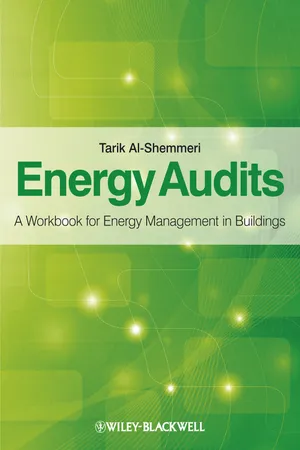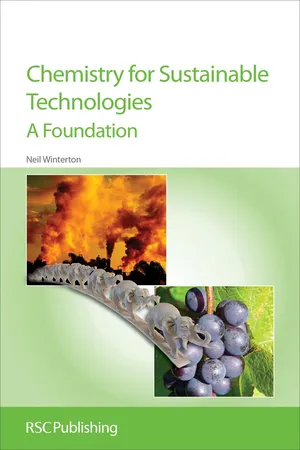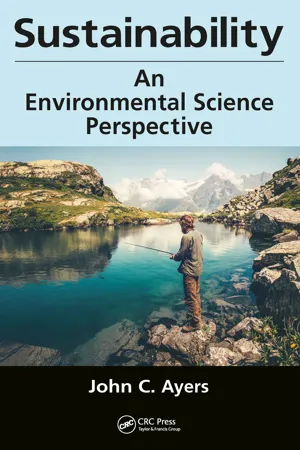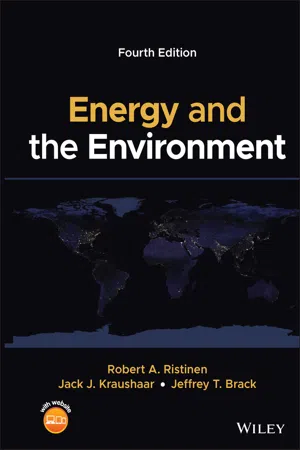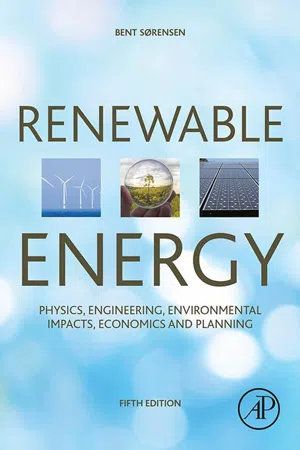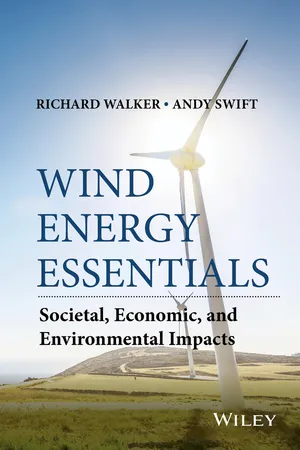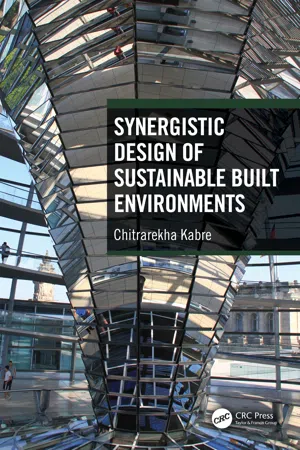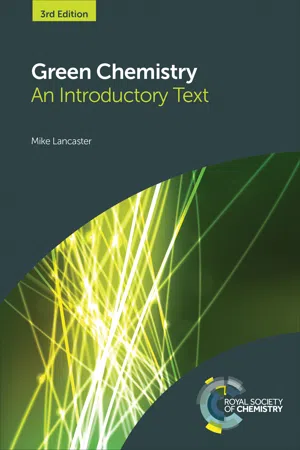Physics
Renewable Energy Sources
Renewable energy sources are natural resources that can be replenished over time, such as sunlight, wind, water, and geothermal heat. These sources are considered sustainable and environmentally friendly alternatives to non-renewable energy sources like fossil fuels. In physics, the study of renewable energy sources involves understanding the conversion of these natural resources into usable forms of energy.
Written by Perlego with AI-assistance
Related key terms
12 Key excerpts on "Renewable Energy Sources"
- eBook - ePub
Energy Audits
A Workbook for Energy Management in Buildings
- Tarik Al-Shemmeri(Author)
- 2011(Publication Date)
- Wiley(Publisher)
Chapter 10Renewable Energy Technology10.1 Introduction 10.2 Solar energy 10.3 Wind energy 10.4 Biomass 10.5 Hydraulic turbines 10.6 Worked examples 10.7 Tutorial problemsLearning outcomes- Demonstrate the various forms of renewable energy
Knowledge and understanding - Describe solar energy and the relationship between latitude, longitude and the different geometrical variables affecting the incident energy from the sun.
Analysis - Describe wind energy, the difference between vertical axis, horizontal axis and the various designs available on the market.
Knowledge and understanding - Describe biomass and its derivatives as renewable fuel
Knowledge and understanding - Calculate the energy potential from all four renewable sources
Analysis - Solve problems associated with renewable energy
Problem solving - Practise further tutorial problems
Problem solving 10.1 IntroductionMuch attention has been paid recently to ‘renewables’ as a potential source of fuel. The rising price of oil and the logistics of supplying fossil fuels to remote areas, together with the environmental incentive, are the main factors driving the push towards renewables. In remote locations, stand-alone renewable energy systems can be more cost effective than extending a power line to the electricity grid. In addition, the environmental benefits, given the current international concerns on global warming, make such a project much more valuable and rewarding.The growth of Renewable Energy Sources also stimulates employment, the creation of new technologies and new skills.The new EU Directive on renewable energy sets ambitious targets for all Member States, such that the EU will reach a 20% share of energy from renewable sources by 2020 and a 10% share of renewable energy specifically in the transport sector. It also improves the legal framework for promoting renewable electricity, requires national action plans that establish pathways for the development of Renewable Energy Sources including bioenergy, creates cooperation mechanisms to help achieve the targets cost effectively and establishes the sustainability criteria for biofuels. - eBook - ePub
Chemistry for Sustainable Technologies
A Foundation
- Neil Winterton(Author)
- 2015(Publication Date)
- Royal Society of Chemistry(Publisher)
Primary sources of energy only require extraction or capture prior to their use. Such sources are reliant on:- solar energy—ultimately derived from nuclear fusion processes
- geothermal energy—ultimately from nuclear fission processes in the Earth’s crust (along with heat conducted from the Earth’s core)
- potential energy associated with gravitational and centrifugal forces.
Fossil sources of energy (e.g. coal, oil and natural gas) fall into this category as, while they result from the capture of historic solar energy, once extracted can deliver energy with little further processing. Similarly, uranium and thorium must also be seen as primary sources, though significant processing is required for their extraction. To the extent that additional fuel may be formed during energy generation (so-called ‘breeder’ technology), nuclear power should be considered renewable—though others may argue that such technologies are not sustainable.12.1.2 Secondary Sources
Secondary sources of energy are those that have to be transformed (with associated exergetic losses) from a primary source into some other form prior to use. This would include the generation of electricity or the production of fuels (also called energy ‘carriers’ or energy ‘vectors’) such as ethanol, hydrogen or petrol (gasoline).Fuels such as hydrogen (or electricity itself) can be used in ways such that no polluting emissions are apparently generated at the point of use. In this limited sense they can be considered clean. However, they cannot be considered renewable, unless the primary source from which they are derived is itself renewable. For example, the hydrogen-powered car produces only water as a co-product when the fuel is combusted or fed to a fuel cell (see below). However, at the moment, most hydrogen is derived from fossil sources. Only when hydrogen can be obtained from a renewable primary source can itself be said to be renewable (and only then to the extent that no fossil resources are used in its production). - eBook - ePub
Sustainability
An Environmental Science Perspective
- John C. Ayers(Author)
- 2017(Publication Date)
- CRC Press(Publisher)
Section 5.4.3 ). This is fortunate, as other sources of energy such as fossil fuels have often been monopolized by the wealthy and powerful to further their wealth and power. Even the poor can afford to use solar cooking, passive solar heating, and biofuels, and as prices for PV panels continue to decrease they are becoming increasingly common in poor villages.As we saw in Chapter 9 , nonRenewable Energy Sources are stock-limited. In contrast, Renewable Energy Sources are flow-limited: we can’t capture energy faster than flowing wind or water provide it. Fortunately, wind and water flow continuously, driven by energy from the sun, so the supplies of Renewable Energy Sources are continuously replenished. Because Renewable Energy Sources are flow-limited, they cannot support an indefinitely growing population, but they can provide an energy base for a sustainable society (Meadows, Randers, and Meadows 2004).However, we have a long way to go before renewables become our dominant energy source. It takes decades to transform the energy infrastructure. Coal burning power plants will have to be replaced by new wind farms, solar panel arrays, biofuel production facilities, hydroelectric installations and, in select areas, geothermal plants. Our current electrical grid will have to be replaced with a smart grid that can transport electricity great distances from wind and solar sources with minimal power loss and that can deal with power generation intermittency (see Chapter 11 ). Currently the growth of renewable energy production is slightly greater than the growth of the Total Primary Energy Supply (TPES), which consists of all energy sources we get energy directly from and excludes secondary energy sources such as electricity and hydrogen gas. The percentage of TPES from renewables (including hydroelectricity) increased from 6.4% in 2011 to 9.3% in 2014 (BP 2015), or ~1% per year.Why hasn’t the percentage of electricity from renewables increased faster than 1% per year? Because electricity consumption is also growing exponentially. This makes it harder for renewables to displace nonrenewables; the growth in electricity consumption eats up most of the growth in renewable energy. Also, the installed base of renewable energy production is so small that it will take several decades for it to catch up with increasing energy demand and make a dent in the amount of fossil fuel consumed. The International Energy Agency (IEA) estimates that we must spend roughly 1% of global GDP between now and 2050 to wean the world off fossil fuels and cut carbon dioxide emissions in half (Sawin and Moomaw 2009). Some believe that we need nuclear power or coal + CCS to address climate change and rising energy demand (Deffeyes 2001; MacKay 2009). However, Sawin and Moomaw (2009) and Jacobsen and Delucchi (2011) claim that renewables plus increased energy efficiency are enough, and that they are the only technologies available now that can do the job. - eBook - ePub
- Robert A. Ristinen, Jack J. Kraushaar, Jeffrey T. Brack(Authors)
- 2022(Publication Date)
- Wiley(Publisher)
5 Renewable Energy Sources II : Alternatives5.1 Introduction
Solar energy can fulfill our energy needs in many wondrous ways. Aside from the direct uses of solar radiation covered in the last chapter, there are also the less direct technologies of hydroelectricity, wind energy, biomass, ocean thermal gradients, ocean currents, and ocean waves for making use of energy from the sun. In addition to using the energy sources of solar origin, we have also learned how to exploit ocean tides and geothermal resources. These are all Renewable Energy Sources that can be explored to see what potential they have for providing useful amounts of energy in an economically and environmentally sound way. The overall flow of energy to and from the earth is shown in Figure 5.1 .Natural energy flow (in units of power) to and from the earth.Figure 5.1Source: M. K. Hubbert (1972). “Man's Conquest of Energy: Its Ecological and Human Consequences,”. In: The Environmental and Ecological Forum 1971–1972. Washington, DC: U.S. Atomic Energy Commission Publication TID‐258575.2 Hydropower
Hydroelectricity is a well‐established technology; it dates back to the beginnings of the electric power industry more than 100 years ago. About 7% of the electric power now generated in the United States comes from our damming the rivers as they flow to the ocean and then releasing the water to turn turbines connected to electric generators. The use of water power is much greater in some other countries; Norway obtains 99% of its electricity from water power, Nepal 95%, Brazil 93%, New Zealand 78%, Canada 58%, and Sweden 50% (half hydro, half nuclear).Hydropower was important long before electricity generation became possible. About 2000 years ago, during the first century BCE, it was discovered that the force of moving water acting on a waterwheel could be used to ease human labor. Various types of ingeniously contrived waterwheel mechanisms were connected by rotating shafts and cogwheels to mills for grinding grain and sawing wood. By the thirteenth century, water power was used to operate hammers in the ironworks of Western Europe, and by the sixteenth century, the waterwheel was the primary source of industrial power in that part of the world. The steam engine eventually replaced water power in many applications, but in selected locations and for certain purposes, water power continued to be the preferred energy source. As our nation developed, mills were established at sites with reliable water flow of sufficient volume and velocity. Communities then grew up around these mills. Dams were built at many such sites to impound the flowing water and to even out the flow over the seasons. After electricity came into practical use, waterwheels were used to drive generators; it then became reasonable to locate hydroelectric plants at a distance from population centers and to transport the electricity over power lines hundreds of miles to the point of demand. Now, we use water power almost exclusively for the generation of electricity, even if there is only a modest distance between the point of generation and the point of use. - No longer available |Learn more
- Gary S. Thorpe(Author)
- 2023(Publication Date)
- Barrons Educational Services(Publisher)
6Energy Resources and ConsumptionLearning ObjectivesIn this chapter, you will learn: ➜What Is Energy? ➜Thermodynamics ➜Renewable and Nonrenewable Resources ➜Global Energy Consumption ➜Fossil Fuels ➜Nuclear Power ➜Biomass ➜Sources of Power (Solar, Hydroelectric, Geothermal, and Wind) ➜Energy ConservationIntroduction to Energy
Energy is defined as the fundamental entity of nature that is transferred between parts of a system in the production of physical change within the system and is usually regarded as the capacity for doing work. The law of conservation of energy states that energy can be converted in form, but not created or destroyed.The sun is the source of energy for most of life on Earth, and, as a star, the sun is heated to high temperatures by the conversion of nuclear energy to heat in its core by the process of nuclear fusion. Inside the sun, this process begins with protons, which are hydrogen nuclei. Through a series of steps, these protons fuse together and are turned into helium. This fusion process occurs inside the core of the sun, and the transformation results in a release of energy that keeps the sun hot. The resulting energy is radiated out from the core of the sun and moves across the solar system.Living organisms require available energy to stay alive. Carnivores get energy from eating other animals, herbivores get energy from eating plants, plants get energy from the sun, and detritivores get energy from consuming dead organic matter.Human civilization requires energy to function. Humans obtain energy from resources such as fossil fuels, nuclear fuel, or renewable energy. The processes of Earth’s climate and ecosystem are driven by the radiant energy Earth receives from the sun and the geothermal energy contained within the Earth. - No longer available |Learn more
- (Author)
- 2015(Publication Date)
- Dunedin Academic Press(Publisher)
9 Non-renewable energy resourcesWhat is energy?
Energy, work and power
It is important, in considering our energy resources, to explain what energy means to the scientist, since the word has a much broader meaning in everyday usage.Energy, strictly defined, means the capacity to perform somework– that is, the ability to provide aforcethat will move an object through a given distance, for example.Poweris the measure of the amount of work that can be done in a given time. Table 9.1 gives definitions of these terms. There are several different forms of energy, the most obvious in the context of the Earth being solar radiation, internal heat and gravitational potential. Many sources of energy are in fact secondary, being derived from these more fundamental forms.Kinetic and potential energy
All moving bodies possess what is known askinetic energy; this increases with the square of the velocity. Thus a cricket ball travelling at 60 miles an hour has four times the energy of one travelling at 30. Gravitational energy, in contrast, is a type ofpotential energy, where the energy of an object of a given mass is proportional to the height through which it can fall, so that a cricket ball held two metres above the ground has only twice the potential energy of one held one metre above. Hydro-electric power exploits the potential energy derived from the height difference between the water in the reservoir and the power station downstream.ENERGY and POWERThe amount of energy expended by a system is measured by the work done plus the heat generated. Thus:The amount of work done by a system is measured by the product of the force employed on a body of given mass and the displacement of that body. Thus:Energy (E) = Work (W) + Heat (Q), i.e. E = W + QWork (W) = Force (F) x Displacement (s), i.e. W = Fs.Work is measured in Joules, where1 joule (J) = 1 newton metre (Nm), i.e. J = Nm - eBook - ePub
Renewable Energy
Physics, Engineering, Environmental Impacts, Economics and Planning
- Bent Sorensen(Author)
- 2017(Publication Date)
- Academic Press(Publisher)
2Origin of renewable energy flows
Abstract
The basic physical processes responsible for availability of Renewable Energy Sources on Earth are described, from formation of and properties of solar radiation, over processes taking place near the surface of the Earth (in atmosphere, hydrosphere, and lithosphere) to comprehensive models attempting to capture enough of the determinants for circulation and climate to be able to understand present and future climates.Keywords
Solar radiation; Energy production in stars; Disposition of radiation at the surface of the Earth; Energy and matter cycles of the Earth; Meteorological models; Climate models; Scales of atmospheric motionIn this chapter, renewable energy is followed from the sources where it is created—notably the Sun—to the Earth, where it is converted into different forms, e.g., solar radiation to wind or wave energy, and distributed over the Earth–atmosphere system through a number of complex processes. Essential for these processes are the mechanisms for general circulation in the atmosphere and the oceans. The same mechanisms play a role in distributing pollutants released to the environment, whether from energy-related activities like burning fossil fuels or from other human activities. Because the assessment of environmental impacts plays an essential part in motivating societies to introduce renewable energy, the human interference with climate is also dealt with in this chapter, where it fits naturally.2.1 Solar radiation
At present the Sun radiates energy at the rate of 3.9×1026 W. At the top of the Earth’s atmosphere an average power of 1353 W m−2 is passing through a plane perpendicular to the direction of the Sun. As shown in Fig. 2.1 , regular oscillations around this figure are produced by the changes in the Earth–Sun distance, as the Earth progresses in its elliptical orbit around the Sun. The average distance is 1.5×1011 - eBook - ePub
Wind Energy Essentials
Societal, Economic, and Environmental Impacts
- Richard P. Walker, Andrew Swift(Authors)
- 2015(Publication Date)
- Wiley(Publisher)
13 NON-WIND Renewable Energy Sources USED TO MEET ELECTRICITY NEEDS13.1 COMPARING SOURCES OF ELECTRIC GENERATION: ATTRIBUTES THAT WILL BE CONSIDERED
All sources of electric generation have positive attributes and negative attributes, and they all seem to have both supporters and detractors. In the following two chapters, we will discuss Renewable Energy Sources (other than wind energy) used for electricity generation and nonrenewable sources of electric generation. Factors relevant to environmental and economic impacts will be considered in hopes of presenting an “apples-to-apples” comparison. The various facts, factors, impacts, and/or issues that will be evaluated include the following:- Installed capacity and net generation in the United States/average capacity factors
- Basics of the technology/efficiency
- Primary operational mode within the electric grid
- Capital cost/variable costs including fuel/levelized cost of energy
- Availability of fuel source and price variability
- Emissions/effect on human health
- Production of solid and/or hazardous wastes and disposal options
- Cooling water requirements/other water requirements
- Impacts to surface water and groundwater quality
- Land use requirements/compatibility with other uses
- Workforce health and safety
13.2 RENEWABLE ENERGY GENERATION RESOURCES IN THE UNITED STATES
The U.S. Energy Information Administration compiles data regarding electricity generation, as well as other types of energy use such as transportation fuels, in their Annual Energy Review [1]. Table 13.1 - eBook - ePub
Energy
Economy and Prospective
- André Gardel(Author)
- 2013(Publication Date)
- Pergamon(Publisher)
§ I later ).§k Nonrenewable reserves and resources
We show in the following the volume of reserves and resources and the geographical distribution of the four principal sources of nonrenewable energy:– coals and lignites – petroleum – natural gas – uranium and thoriumWe add a brief indication on deuterium in the view, still uncertain, of a subsequent exploitation of nuclear fusion.The sources of the numbers given are numerous and diverse. We have therefore made a choice without pretending to give incontestable numbers here: the observations of the previous paragraph show clearly that such numbers do not exist, partly because of our limited knowledge of the geological situation and partly because of the numerous subjective judgments necessary. Moreover, the estimates vary constantly. Our aim is only to identify the orders of magnitude to give a correct picture of the over-all situation.For the fossil fuels, and as for the energy values indicated in paragraph i, the quantities indicated are in available energy (product of mass times energy value, thus by the calorific power); these numbers should be multiplied by 0.7 approximately to obtain the usable energy, that is to say the primary energy as we have defined it in paragraph d.k1 Coals, lignites
A detailed study made by the World Energy Conference, based on the 1974 situation, leads to the quantities shown in Table 2.19 - Chitrarekha Kabre(Author)
- 2020(Publication Date)
- CRC Press(Publisher)
Water is an extraordinary source of renewable energy, especially moving water via gravity, waves or tides is a source of kinetic energy. Historically the force of water flowing in the streams and rivers was used to produce mechanical energy for grinding grains into flour, saw wood, and other works. It is also a tremendous source of thermal energy stored from the sun. The earth’s oceans are sources, too, of tidal energy, wave energy, and thermal energy, all of which can be harnessed to generate electricity. A hydroelectric power or hydropower is the electricity created when the kinetic energy is harnessed from flowing water. Moving water turns a turbine and shaft, which spins a generator that produces electricity. Hydroelectric power produced 21.76% of the total renewable electricity in the United States in the year 2019, and 2.5% of the total US electricity. The water cycle makes the hydropower a sustainable option since solar energy evaporates surface water into clouds and recycles back to the earth as precipitation. Hydropower systems come in all sizes and can be distinguished in three categories as per DOE: large-scale hydropower plants with a capacity of more than 30 MW, small-scale hydropower system that generates 10 MW or less of power, and micro hydropower systems having a capacity less than 100 kW. The large hydropower plants are three types: impoundment, diversion, and pumped storage. An impoundment facility, the most common type of hydroelectric power plant, involves the construction of a large dam to store river water in a reservoir. Water released from the reservoir flows through a turbine, spinning it, which in turn activates a generator to produce electricity (Figure 5.26). This type of hydropower plant has environmental concerns because of displacement and/or destruction of natural habitats, terrestrial, and aquatic ecosystems resulting from the construction of the dam and hydropower plants- eBook - ePub
Green Chemistry
An Introductory Text
- Mike Lancaster(Author)
- 2020(Publication Date)
- Royal Society of Chemistry(Publisher)
CHAPTER 6 Renewable Resources6.1 Biomass as a Renewable Resource
All living material may be considered as biomass, but commonly, only nonanimal renewable resources such as trees and crops that may be harvested for energy or as a chemical feedstock tend to be referred to as biomass. Although the total amount of biomass available at any one time is relatively small, some estimates putting the figure at under 2000 billion tonnes (including water contained in the cells), unlike fossil resources, it is readily renewable on a time scale useful to mankind. The energy for this renewal process comes from the sun, with around eight times our annual energy consumption (5 × 1020 J) being fixed each year through photosynthesis. This is equivalent to the generation of some 70 × 109 tpa of organic matter. For most of the history of mankind, biomass was the only source of energy, and even with our current heavy reliance on fossil fuels, biomass still accounts for around 12% of the world’s energy use (Figure 6.1 ). This use is heavily concentrated in developing countries like India and southern Africa but many well-forested developed countries still use significant amounts of wood for burning, in recent years there has been a gradual swing with developed nations using more biomass to produce transport fuel and electrical energy and third-world countries using more coal and oil as they develop industry.Figure 6.1 Sources of world energy.6.2 Energy
6.2.1 Fossil Fuels
The era of society’s almost total dependence on fossil resources is likely to largely come to an end towards the end of the twenty-first century, although estimates change on almost a yearly basis. Conventional supplies of oil and coal are diminishing and new fields are often in the most remote and difficult to access parts of the world. However, the rapid development of unconventional or shale gas in the US and the anticipation of development in Europe could mean that fossil resources will continue to be fairly readily available for another 100 years or so. The general trend of ever-increasing fossil-fuel prices is likely to continue in the long term (although at the time of writing oil prices are at a historical low), coupled with the fact that consumption of fossil fuels is a significant cause of climate change and global warming has led to the growing need for alternative feedstocks to replace fossil resources. For energy use there are several options including wind, water, solar and nuclear as well as biomass. For organic chemical production the only nonfossil option is biomass (with possibly a small contribution from atmospheric CO2 - eBook - ePub
- James A. Momoh(Author)
- 2018(Publication Date)
- Wiley-IEEE Press(Publisher)
Policies are necessary to ensure that DG systems adhere to some quality of supply and to maintain system frequency. High voltage levels approved for DG connections relative to the utility company must also be known and properly controlled to achieve voltage security and respond to changing market conditions. This flexibility in construction of lines and centralized generation has made the DG market economically attractive.Major policy issues surrounding DG include:- high cost of implementing various DG technologies—a concern of policy makers and stakeholders
- less choice between costlier DG with expensive fuel supply—a fact that has discouraged the selection of DG compared with central generation
- policies to ensure economic efficiency of DG selection to liberalize the market
9.4 WORKING DEFINITIONS AND CLASSIFICATIONS OF RENEWABLE ENERGY
Renewable energy is energy derived from natural sources that replenish themselves over a short period of time. These resources include sun, wind, hydropower, organic plant and waste material (biomass), and earth heat (geothermal). Whereas renewable resources can generate both electricity and heat, the term “green power” is used in a narrow sense to mean electricity products generated from renewable sources that are environmentally and socially acceptable.9.4.1 Solar
Photovoltaic (PV) cells and modules are configurable from 1 to 5 MW. Figure 9.1 shows a typical modern PV system. In 1839, French physicist Edmond Becquerel was the first to discover that certain materials exposed to light produce current. Refinements at Bell Laboratory in 1954 led to the development of silicon-based PV cells, producing electricity conversion with more than 4 percent efficiency.Figure 9.1PV systems integration with microgrid.Following the energy crisis in recent years, the use of solar power has become more widespread. Commonly known as solar panels, PV modules are commercially available, provide no emissions, are an alternative to other energy sources, are reliable, and require minimum maintenance to operate. However, they are expensive compared with other renewable-energy options and up to four to six times larger than complicated alternative technologies. Today, advances in material science have led to the engineering and fabrication of solar panels with about 30 percent efficiency.
Index pages curate the most relevant extracts from our library of academic textbooks. They’ve been created using an in-house natural language model (NLM), each adding context and meaning to key research topics.
